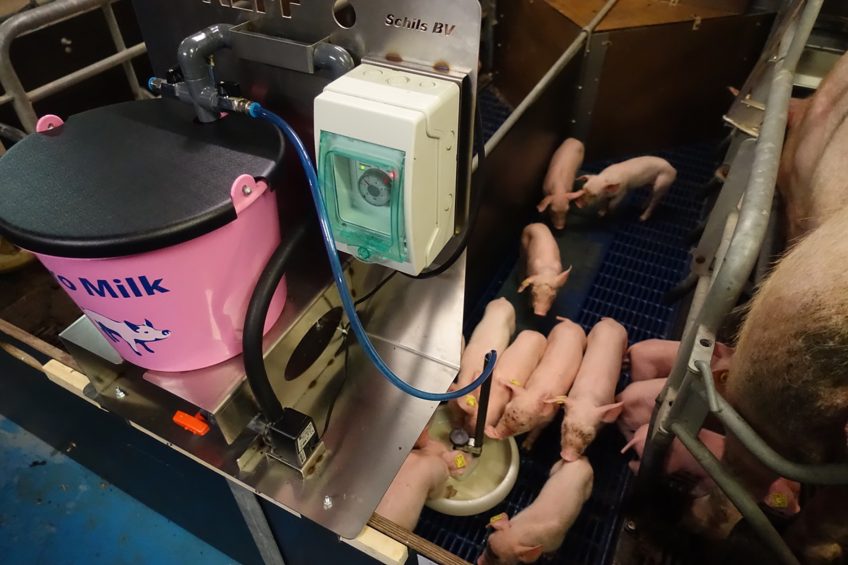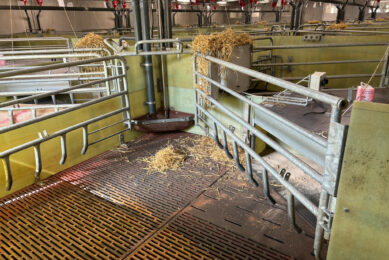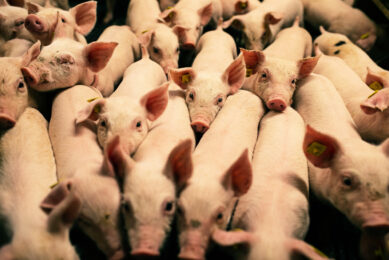22 piglets at one sow and it is no problem

Modern genetics have created hyperprolific sows, which regularly have litters with more piglets than teats. The result: relatively high mortality figures amongst piglets and often a puzzle of how to get every piglet that lives all the way to weaning. A simple solution might help overcome that.
Imagine a lactating sow having 22 piglets. Madness, you say? Or will you respond by saying something like – that will lead to many piglets being crushed.
Nothing of the sort – 22 is perfectly well possible, according to the team at young animal feed specialist Schils, headquartered in Sittard, in the south of the Netherlands. At this EuroTier, the company, in the swine business known for supplementary milk products for piglets, will introduce a method as to how this is possible. As it goes with many innovations – simplicity and logic can achieve a lot.
Foster sows
Highly prolific sows are a common phenomenon these days, as e.g. sows of Danish origin usually produce large litters. Now let’s zoom out a little: What would normally happen if the number of piglets exceeds the number of available teats? Farms can opt to create foster sows, i.e. sows from a different week group which, instead of going back for a next breeding cycle, will be giving milk for a prolonged time. The practice has a number of advantages as it will allow the supernumerary piglets to grow up – and in the EU officially it isn’t allowed to rear very young piglets without a sow anyway.
The practice, however, does come with various disadvantages as well. It costs money, keeping a sow away from a next cycle of production, as all the time she spends on lactating the new piglets is ‘lost’ for breeding purposes. Hence the practice of fostering will usually have an effect on the farm’s total efficiency. Additionally, a foster sow which farrowed a month ago or longer gives a different type of milk than a sow does a few days after farrowing. That might mean that piglets may not ingest the exact type of nutrients they need. Thirdly, cross-fostering with sows from a different week group is quite a logistical operation, which in turn could lead to stress with the animals or a higher risk of infections.
A member of the VanDrie Group
Schils, as young animal feed specialist, is a member of the VanDrie Group. This Dutch-based agribusiness is one of the larger players in the international veal market, processing about 1.6 million calves every year. Apart from veal processing, the agribusiness family also includes companies focusing on calf husbandry, dairy raw materials, calf skins and feed production – the last section including Schils. The company obtains part of its raw materials through Eurolat, a German-based family member within the VanDrie Group. Apart from milk products for piglets, Schils also focuses on making products for e.g. calves and lambs. For pigs, the company markets a three-step concept, called Pigipro, running from milk after colostrum to extra growth after weaning. Most of the products come in a powder form and water needs adding prior to use. The second and third steps are also available in a pelleted form.
Solving the lactation capacity problem
The novel solution to overcome the lactation capacity problem is called ‘ALFF’, an easily transportable device which allows farmers to temporarily increase a farrowing pen’s milk capacity. The company’s innovation manager Jo Heusschen likes to compare it to an ‘Ikea’ idea. He says, “It is a very easy concept, easy to dismantle and easy to move.”
The technology was developed by Paul Steeghs, who used to be a pig breeder himself until recently. The essence of the idea is to keep all piglets with a sow, but just provide them with a little bit of extra milk in a cup which is supplied by an automatic dispenser – the Automatic Liquid Flexible Feeder (which makes the acronym ALFF). When connected to the electricity network, the machine can supply an amount of the milk to the cups every hour, at a frequency just like a sow would. This makes the piglets constantly interested and prevents the cup from becoming dirty. One flexible feeder can serve two sows simultaneously.
Clever swine farmers will immediately see the added value of this concept, adds Mr Heusschen. After all, the system also allows creating foster sows within the same week group. In this case one litter can be divided over two other sows aided by a flexible feeder, one sow can be freed up to help others. In this case no sow is taken out of her production cycle, as she is doing what she was meant to do anyway, see Figure 1.
Apart from the supporting function the Schils team identified a second strategy for the liquid flexible feeder – predominantly applicable outside the European Union: that of motherless rearing. Inside the EU, motherless rearing is not encouraged for welfare reasons, but outside Europe this might be a strategy worth considering for swine farms.
Figure 1 – Schematic drawing of how an automatic liquid flexible feeder can turn three litters into two. The blue piglets together formed a litter of a sow that is ‘freed up’ for foster sow purposes within the same week group.
Practical application
So far for the theory – how does the concept work in practice? In spring 2018, Schils’ nutritionist Nicole Lousberg had a trial set up at the Swine Innovation Centre (VIC), part of Wageningen University, the Netherlands. Litters of 40 gilts and sows joined in the trial – one half formed the control group, with the piglets receiving a regular pre-starter twice a day as from day 2 after farrowing. The other half received support of the flexible feeder, 24 times a day a limited quantity every time, according to the company’s feeding portfolio (see box). In order to be able to measure the effects equally, litter sizes were standardised at 15 piglets. Weaning occurred at 28 days in both groups.
The trial yielded that at weaning, piglets in the group receiving support were heavier than the piglets in the control group. At 14 days of age, the piglets in the group receiving support were 530 g heavier than those in the control group – a weight difference that grew towards the end of the weaning phase. In comparison to the control group, 21% more piglets were weaned with a weight of more than 8 kg, and 3.6% fewer piglets were weaned with a weaning weight of lower than 6 kg.
In addition, the research team found, the intake of the milk replacer did not reduce the intake of the weaner diet but rather increased the overall feed intake.
Trial aimed at reducing motherless rearing
A second trial focused on the reduction of motherless rearing, and this was done on an independent trial farm in Oirschot, the Netherlands, in June 2018. After all, with the support of the liquid flexible feeder, sows can rear more piglets, which in turn do not have to be raised ‘motherless’. Sows were observed to deal with 21 and 19 piglets. The group of 206 piglets achieved an average growth of 199 g/day as long as the liquid flexible feeder was used during 19 days.
Interestingly, the total mortality rate was 3.89% from day 2 until weaning. On average, this figure in the Netherlands is at 13.4%.












